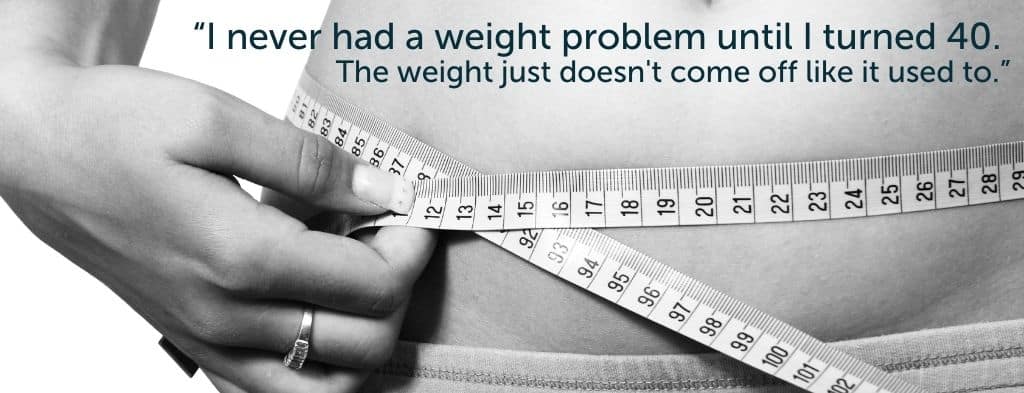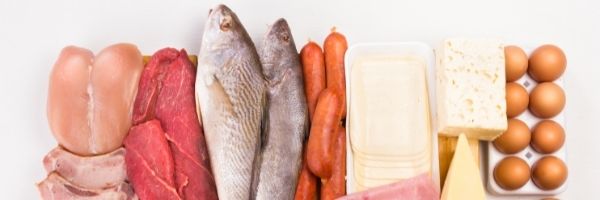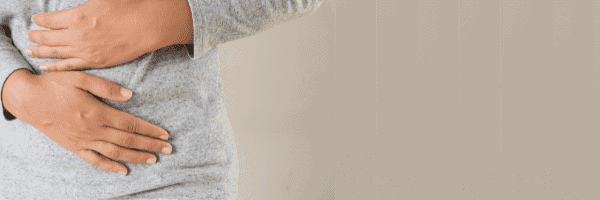Midlife Nutrition
Helping Women Over 40 Overcome Nutrition Challenges
By Maryann Jacobsen, MS, RD

If you work with women aged 40 and older, this complaint probably sounds all too familiar. The challenges facing female clients in midlife regarding nutrition and overall health can seem insurmountable to them. Whether it’s unwanted weight gain, the loss of lean body mass, bone health concerns, or other issues that occur during the years leading to menopause and beyond, there’s much dietitians can do to help these women remain healthy and stronger than ever.
Culprits Behind the Weight Gain
One of the most irksome challenges facing women in midlife is unwanted weight gain. According to 2003-2004 National Health and Nutrition Examination Survey (NHANES) data, the largest jump in the percentage of women who become overweight or obese occurs between the ages of 20 and 39 (51.7%) and 40 and 59 (68.1%).1 Research indicates that hormonal changes are responsible for the increases in body fat, especially in the midsection. The female hormone estrogen begins to decline during perimenopause, the time during which a woman’s body makes its natural transition to menopause, although erratically, and it decreases further along with progesterone when menstruation ends. Perimenopause usually begins in a woman’s 40s but can begin as early as the mid-30s, according to the Mayo Clinic website.
Menopause occurs one year after the last period, typically at age 51. These hormonal changes increase the rate at which women store visceral fat, which surrounds the vital organs deep within the abdomen, and precipitate changes in insulin sensitivity and glucose metabolism, putting them at increased risk of cardiovascular disease and diabetes.2 Emerging research has revealed that changes at the cellular level cause menopausal women to store more fat with a diminished ability to burn fat.3
“Due to a loss of estrogen, fat is metabolized differently,” says Colleen Keller, PhD, regents professor and director of Arizona State University’s Center for Healthy Outcomes in Aging. “It’s actually laid down differently in the body as subcutaneous fat.”
Keller argues that these changes associated with midlife aren’t to be feared but to be accepted as a normal part of aging. She believes arming women with strategies to decrease weight gain and chronic disease risk is key in helping them anticipate physiologic and metabolic changes.
Research shows estrogen therapy helps prevent some of these age-related changes4; however, it’s no longer recommended for all women because of potential adverse effects such as an increased breast cancer risk.5 It’s important for women to talk with their physician about hormone therapy, as it can be beneficial for some women, including those who experience premature menopause (before age 40).5
Physical Activity
The good news is that there’s a not-so-secret weapon that can help women fight the inevitable weight gain: exercise. Physically active women who enter menopause are leaner than inactive women and have a decreased risk of developing metabolic disease.6 According to a longitudinal study that included the Study of Women’s Health Across the Nation cohort, women whose activity decreased the most packed on the most pounds overall as well as in the midsection. Those who maintained their weight throughout the study participated in an average of 60 minutes of activity per day, the same amount recommended for the average adult by the Institute of Medicine (IOM).7

“Women in midlife begin to start suffering from a new STD: sitting-to-death disease,” says Bonnie Roill, RDN, MBA, CPT, CWC, owner of Aspire2Wellness, who counsels women in midlife. “I recommend a standing desk or standing while on the phone. Setting the alarm on the computer to remind the person to stand up and walk around a bit.”
Lean Body Mass
Research has shown that while changes in fat distribution can be attributed to hormonal shifts experienced by women in midlife, overall weight gain that occurs with age (about 1 lb per year) primarily is due to the effects of aging, such as decreased activity and a loss of lean body mass, which is more metabolically active than fat.6
“Loss of lean body mass starts in the 30s and 40s,” says Douglas Paddon-Jones, PhD, a professor in the department of nutrition and metabolism at The University of Texas Medical Branch. “Women need to understand the impact diet has on muscle loss the same way they understand how diet affects osteoporosis risk.”
Paddon-Jones explains that after age 40, women lose about 1% of their lean body mass per year if they’re inactive. He says all types of exercise are important to maintain and build muscle, from cardio and strength training to yoga. For example, cardiovascular exercise, such as brisk walking or jogging, strengthens the heart and lungs, helps improve the blood sugar and insulin response, and strengthens large muscle groups, while strength training helps build lean body mass in the arms, legs, and upper and lower back.
Protein Intake
In addition to participating in physical activity to maintain and build muscle, women in midlife also should strive to eat protein during meals to promote muscle-protein synthesis, which is essential to the body’s ongoing growth, repair, and maintenance of skeletal muscle, according to Paddon-Jones.
In his research, Paddon-Jones has found that as much as 25 to 30 g of protein is needed at each meal to optimally stimulate muscle-protein synthesis.8 For example, in one study, subjects who received 90 g of protein evenly distributed among three meals (30/30/30) experienced a larger anabolic response to the meals after 24 hours compared with those who received a more uneven distribution (10/20/60).9 Another study, published in the Journal of the Academy of Nutrition and Dietetics, found that, in a single meal, 30 g of protein had the same anabolic effect as 90 g, showing that after about 30 g, protein synthesis is maxed out.10

What’s behind this may be the amino acid leucine, which is needed to “turn on the protein-synthesis machinery” as people age, Paddon-Jones explains.
“This is a big change for many people who have toast for breakfast and a salad for lunch followed by a big chicken breast for dinner,” says Nancy Clark, MS, RD, author of Nancy Clark’s Sports Nutrition Guidebook. “They need to redistribute their protein evenly throughout the day.”
Paddon-Jones adds that if women skimp on protein after workouts, it’s a missed opportunity to help build muscle mass. He says dietitians can help clients find creative ways to boost their protein intake, especially at breakfast, during which the average American gets only about 10 g.11
In addition to eating sufficient protein and balancing intake across the day, eating the proper amount and type of carbohydrate can help cut calories and control blood sugar. Roill recommends swapping high-glycemic foods such as frappuccinos and cookies for those with a lower glycemic index, such as an apple with cheese or peanut butter, since many of her female clients approaching menopause have been diagnosed with prediabetes. She suggests women eat in reverse: the larger meal at breakfast and the lightest meal at dinner, and reduce calories from beverages such as alcohol, coffee drinks, and smoothies, which tend to be calorically dense. “The reduction in caloric needs as we age coincides with a time in many [women’s] lives when they have the income and time to socialize, vacation, etcetera,” she says. “These activities are closely tied to dining out and the opportunity for consuming excessive calories.”
Bone Health
Another concern for women is the depletion of bone density, which often occurs after menopause when the ovaries stop producing estrogen. Women can lose as much as 20% of their bone density five to seven years after menopause.12 The best case scenario, experts say, is for women to enter menopause with sufficient bone density to minimize subsequent losses.
“There’s a critical window for bone loss, which occurs one to two years before a woman’s last period and five years after that,” says Diane L. Schneider, MD, author of The Complete Book of Bone Health. “Between waning hormones, weight gain, and changes in physical activity, there’s a synergistic effect on bone in women as they age.”
Schneider says calcium, vitamin D, adequate protein, not smoking, and exercise are key components to decreasing the amount of bone loss. In one study, researchers estimated that women aged 80 who don’t smoke, are physically active, and have a BMI of 25 will lose 25% to 38% less bone than women of the same age who smoke, are sedentary, and are thin.13
Low BMI is a known risk factor for osteoporosis and fractures. In a 2005 meta-analysis, those with a BMI of 20 had almost double the risk of hip fracture compared with those with a BMI of 25.

After age 50, the Recommended Dietary Allowance (RDA) for calcium climbs to 1,200 mg/day, which makes meeting calcium needs challenging, especially since calcium supplements now are recommended less often because of potential heart disease risks.
Schneider suggests a food-first approach to increasing calcium intake and using supplements as a way to fill in the gaps. “One day you may need to supplement, and another day [you may not],” she says. “And women should take no more than 500 to 600 mg at a time, since more than that isn’t utilized by the body.”
Schneider says vitamin D supplementation should be based on an individual patient’s blood levels. There’s debate about what the optimal vitamin D blood levels should be for bone health. The IOM’s 2010 report, based solely on vitamin D’s role in bone health, states the baseline target should be 20 ng/mL,14 while the Endocrine Society recommends a target of 30 ng/mL.15 Schneider says the best recommendation for optimal vitamin D levels to maintain muscle and bone health is no lower than 30 ng/dL. “It takes at least 1,000 to 2,000 IU of vitamin D to maintain levels over 30,” she adds.
Just as physical activity is important to maintain lean body mass, it’s also vital for preserving bone health. Weight-bearing exercises such as jogging and walking and resistance training are beneficial because they add force to the body, which sustains bone density. “Recommendations for exercise jump from 30 minutes per day of activity to 60 minutes per day when transitioning to menopause,” Schneider says. “Without exercise, stem cells are more likely to become fat cells.”
Keeping track of daily activity by wearing a pedometer and tallying the number of steps taken while adding resistance exercise works well for busy women, she adds.
Roill, who feels strongly that women in midlife should embrace resistance training, suggests RDs recommend their clients purchase a set of dumbbells and instructional DVDs to get them started, especially if they have no previous experience with exercise. “The goal is for clients to work out with weights a minimum of two times per week,” she says.
Other lifestyle factors that can negatively affect bone health include excess alcohol consumption and a family history of osteoporosis. Certain drugs such as proton pump inhibitors for acid reflux disease, selective serotonin reuptake inhibitors for depression, and certain diabetes and breast cancer medications also can deplete bone density. In addition, diabetes can increase osteoporosis risk because the disease decreases the rate of bone turnover, Schneider says.
Women who have a family history of diabetes or other risk factors should have their first bone density test during the perimenopausal years, Schneider says. Women at low risk of osteoporosis should discuss the best timing for a bone density scan with their primary care physician.
Hot Flashes and Sleep Disturbances
Along with concerns of bone health, women in midlife can experience sleep disturbances as they transition to menopause. According to the National Sleep Foundation, up to 61% of postmenopausal women report symptoms of insomnia, which include trouble falling or staying asleep for three or more nights per week for one month.16
The decline in estrogen and progesterone, which leads to hot flashes in about 75% to 85% of women, contributes to insomnia.16 Hot flashes can disrupt sleep because body temperature dramatically rises, leading to night sweats that cause sudden waking. Most women experience hot flashes for about one year, but some experience them for up to five years. Anxiety and depression at midlife also may contribute to sleep problems.16

It’s important for dietitians to address sleep quality with clients and patients because sleep loss interrupts appetite regulation by elevating levels of the hunger hormone ghrelin and decreasing the satiety hormone leptin, which can raise the risk of weight gain.17 Recommendations from the Harvard Medical School Division of Sleep Medicine can help dietitians advise their clients to improve sleep quality and include refraining from drinking caffeinated beverages four to six hours before bedtime and alcohol within three hours of bedtime, practicing a regular sleep routine, eating a light evening meal, exercising early in the day or at least three hours before bedtime, and going to bed only when tired.18
There are other options for peri- and postmenopausal women who are having trouble sleeping. “I focus on the importance of sleep, and an effective way to get rid of night sweats and hot flashes is to take a very low (non-therapeutic) dose of the antidepressant Effexor [venlafaxine hydrochloride),” Clark says of the prescription medication. “It works like a charm. Once a woman gets enough sleep, she has the energy to exercise and to eat better.” Sleep disorders such as restless leg syndrome and sleep apnea also can contribute to poor sleep quality, so making sure patients get treated for these conditions is important.
Gastrointestinal Changes
Other issues that women in midlife may face include changes in digestion. Fluctuations in ovarian hormones may contribute to belly bloating and sluggish intestines, says Kate Scarlata, RDN, CDN, author of The Complete Idiot’s Guide to Eating Well With IBS. The same gastrointestinal (GI) symptoms that occur during pregnancy, premenses, and menses—bowel discomfort, abdominal pain, bloating, and altered bowel patterns—also occur during perimenopause and menopause. Researchers believe it’s the fluctuations in ovarian hormones that contribute to GI distress.19
Scarlata says that gut microbiota changes with age,20 with a decline in the number and variety of protective microbes, but she says researchers aren’t sure how that specifically impacts GI issues in midlife. Dietitians can counsel women who have endured chronic antibiotic use, and therefore a decrease in beneficial gut bacteria, about probiotics that can help bring their gut flora back into balance.

Some women develop lactose intolerance as they age, so incorporating lactose-free milk, cottage cheese, and yogurt into their diet will enable them to continue to eat dairy products and help them meet their calcium needs.
Scarlata recommends clients follow a low-lactose diet if gas and bloating are related to milk consumption. And she advises patients drink six to eight 8-oz glasses of water daily and eat adequate amounts of fiber (approximately 25 g/day) that are less gassy, such as chia seeds, pumpkin seeds, strawberries, and baked potatoes with the skin on vs. choosing inulin or whole wheat fibers, which can cause more GI distress.
Changing Nutrient Needs
When it comes to nutrient needs, women who have reached menopause don’t need as much iron as they used to because they no longer menstruate; the RDA drops from 18 to 8 mg/day.
Folic acid, which helps protect unborn children against neural tube defects in the womb, no longer is a concern since postmenopausal women can’t get pregnant. Some research suggests that too much folic acid from fortified foods and supplements may increase the risk of certain cancers,21 so discussing folic acid supplements and fortified foods with postmenopausal women is important.

Because the risk of cardiovascular disease, diabetes, and weight gain rises after menopause, helping women choose a diet rich in nutrients but lower in caloric density is key, as is choosing healthful fats, lean sources of protein, low-fat dairy or dairy alternatives, and plenty of fruits and vegetables.
Final Thoughts
While women in midlife face many challenges, such as hormonal changes that lead to weight gain, loss of bone and muscle mass, and digestive issues, there’s much they can do with the help of dietitians to begin a healthful transition into the postmenopausal years. Counseling clients about the importance of evenly distributing protein among meals, eating nutrient-dense foods, consuming fewer calories because of reduced energy needs, getting adequate amounts of vitamin D and calcium, and engaging in physical activity such as aerobic and strength training exercise will help burn unwanted fat, build muscle and bone, and prevent metabolic disease.
Dietitians can help women realize that bodily changes start well before midlife, and that they can benefit from knowing what to expect beforehand and how best to prevent the negative effects of aging. RDs are in the perfect position to empower women before, during, and after menopause so they can live their healthiest lives and let them know that the best is yet to come.
— Maryann Jacobsen, MS, RD, is a freelance writer based in San Diego.
References
1. Ogden CL, Carroll MD, Curtin LR, McDowell MA, Tabak CJ, Flegal KM. Prevalence of overweight and obesity in the United States, 1999–2004. JAMA. 2006;295(13):1549-1555.
2. Keller C, Larkey L, Distefano JK, et al. Perimenopausal obesity. J Women Health (Larchmt). 2010;19(5):987-996.
3. Santosa S, Jensen MD. Adipocyte fatty acid storage factors enhance subcutaneous fat storage in postmenopausal women. Diabetes. 2013;62(3):775-782.
4. Davis SR, Castelo-Branco C, Chedraui P, et al. Understanding weight gain at menopause. Climacteric. 2012;15(5):419-429.
5. Hormone therapy: is it right for you? Mayo Clinic website. http://www.mayoclinic.org/diseases-conditions/menopause/in-depth/hormone-therapy/ART-20046372
6. Sternfeld B, Dugan S. Physical activity and health during the menopausal transition. Obset Gynecol Clin North Am. 2011;38(3):537-566.
7. Sternfeld B, Wang H, Quesenberry CP Jr, et al. Physical activity and changes in weight and waist circumference in midlife women: findings from the Study of Women’s Health Across the Nation. Am J Epidemiol. 2004;160(9):912-922.
8. Paddon-Jones D. Lean body mass loss with age. Abbott Nutrition website http://images.abbottnutrition.com/ANHI2010/MEDIA/14-110th AN Conf Paddon-Jones Final.pdf. Accessed December 27, 2013.
9. Paddon-Jones D, Rasmussen BB. Dietary protein recommendations and the prevention of sarcopenia. Curr Opin Clin Nutr Metab Care. 2009;12(1):86-90.
10. Symons TB, Sheffield-Moore M, Wolfe RR, Paddon-Jones D. A moderate serving of high-quality protein maximally stimulates skeletal muscle protein synthesis in young and elderly subjects. J Am Diet Assoc. 2009;109(9):1582-1586.
11. Layman DK. Dietary guidelines should reflect new understandings about adult protein needs. Nutr Metab (Lond). 2009;6:12 .
12. National Osteoporosis Foundation. Hormones and Healthy Bones. Washington, D.C.: National Osteoporosis Foundation; 2009.
13. Wilsgaard T, Emaus N, Ahmed LA, et al. Lifestyle impact on lifetime bone loss in women and men: the Tromso study. Am J Epidemiol. 2009;169(7):877-886.
14. Ross AC, Taylor CL, Yaktine AL, Del Valle HB (eds). Dietary Reference Intakes for Calcium and Vitamin D. Washington, D.C.: National Academy Press; 2011.
15. Holick MF, Binkley NC, Bischoff-Ferrari HA, et al. Evaluation, treatment, and prevention of vitamin D deficiency: an Endocrine Society clinical practice guideline. J Clin Enocrinol Metab. 2011;96(7):1911-1930.
16. Menopause and sleep. National Sleep Foundation website. http://www.sleepfoundation.org/article/sleep-topics/menopause-and-sleep. Accessed December 28, 2013.
17. Shlisky JD, Hartman TJ, Kris-Etherton PM, Rogers CJ, Sharkey NA, Nickols-Richardson SM. Partial sleep deprivation and energy balance in adults: an emerging issue for consideration by dietetics practitioners. J Acad Nutr Diet. 2012;112(11):1785-1797.
18. Twelve simple steps to improve your sleep. Harvard Medical School Division of Sleep Medicine website. http://healthysleep.med.harvard.edu/healthy/getting/overcoming/tips. Accessed December 31, 2013.
19. Heitkemper MM, Chang L. Do fluctuations in ovarian hormones affect gastrointestinal symptoms in women with irritable bowel syndrome? Gend Med. 2009;6 Suppl 2:152-167.
20. Mariat D, Firmesse O, Levenez F, et al. The firmicutes/bacteroidetes ratio of the human microbiota changes with age. BMC Microbiol. 2009;9:123.
21. Shelke N, Keith L. Folic acid supplementation for women of childbearing age versus supplementation for the general population: a review of the known advantages and risks. Int J Family Med. 2011;2011:173705. doi: 10.0055/2011/173705.
